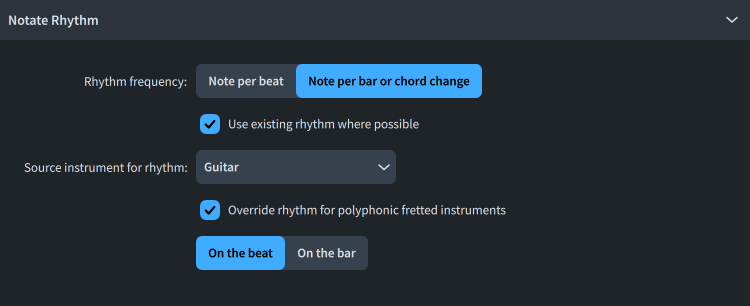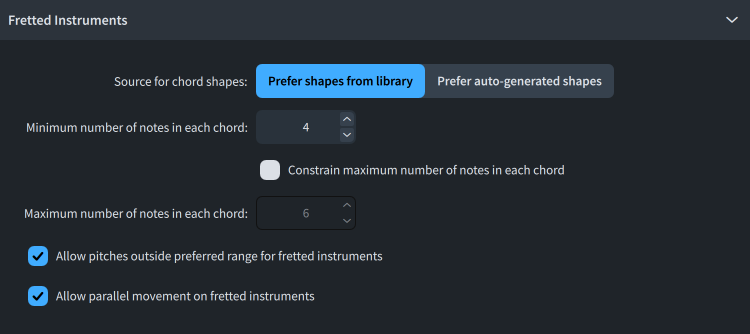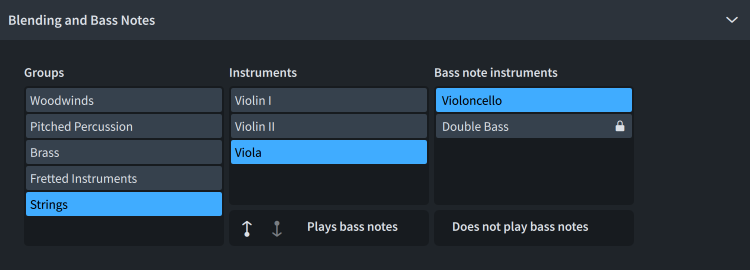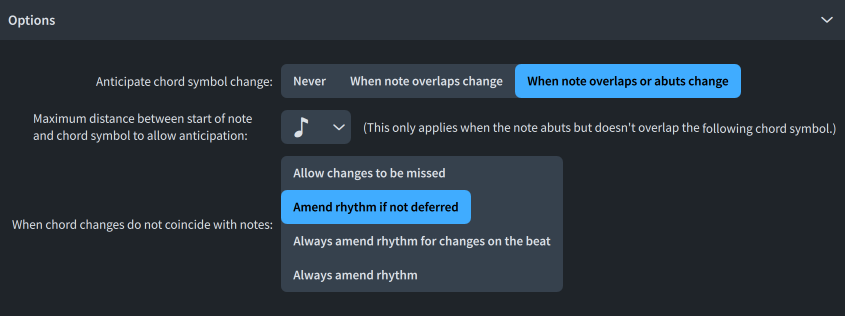Generate Notes From Chord Symbols dialog
The Generate Notes From Chord Symbols dialog allows you to generate notes based on the harmony of chord symbols you have already input, and influence many related variables, such as voice leading and which instruments play bass notes.
-
You can open the Generate Notes From Chord Symbols dialog in Write mode by choosing . You can also choose this option from the context menu.
You can hide/show each section by clicking the corresponding section header.
Notate Rhythm
The Notate Rhythm section allows you to influence the rhythm of generated notes, and whether you want to use rhythms from an instrument with existing notes.

The Notate Rhythm section contains the following options:
- Rhythm frequency
-
Allows you to change the rhythmic interval between generated notes.
-
Note per beat: Notes are created every beat, according to the prevailing time signature.
-
Note per bar or chord change: Notes are created every bar or at every chord symbol change, whichever comes first.
-
- Use existing rhythm where possible
-
Allows you to select an instrument with existing notes from the Source instrument for rhythm menu, whose rhythm you want to use for generated notes. Shorter existing rhythms are repeated to fill the selected duration. Only available when at least one instrument has existing notes that start and end within your selected duration.
- Override rhythm for polyphonic fretted instruments
-
Allows you to override the generated rhythms for fretted instruments, and simplify their rhythms to one of the available options. For example, if you want to generate complex rhythms for most of the ensemble, but want the guitar only to play quarter notes. Only available when your selection includes at least one fretted instrument.
-
On the beat: Notes are created every beat, according to the prevailing time signature.
-
On the bar: Notes are created at the start of each bar.
-
Fretted Instruments
The Fretted Instruments section allows you to influence the notes, and the resulting chord shapes, generated on staves belonging to fretted instruments. Only available when your selection includes at least one fretted instrument.

The Fretted Instruments section contains the following options:
- Source for chord shapes
-
Allows you to change the primary source for chord shapes.
-
Prefer shapes from library: Dorico Pro prefers common shapes that are easier to play.
-
Prefer auto-generated shapes: Dorico Pro prefers shapes with stronger voice-leading.
-
- Minimum number of notes in each chord
-
Allows you to set the minimum number of notes for each chord.
- Constrain maximum number of notes in each chord
-
Allows you to limit each chord to the number of notes set in the Maximum number of notes in each chord value field.
- Allow pitches outside preferred range for fretted instruments
-
Allows you to override your settings for restricting pitch ranges in .
- Allow parallel movement on fretted instruments
-
Allows you to override your settings for restricting parallel movement in .
Miscellaneous Polyphonic Instruments (e.g. keyboard instruments, harp etc.)
The Miscellaneous Polyphonic Instruments (e.g. keyboard instruments, harp etc.) section allows you to set the minimum and maximum number of notes you want to generate in each chord for polyphonic instruments. For example, if the polyphonic instrument in your selection is a marimba, and you know the performer can only hold two sticks per hand, you can set the maximum number of notes to 4.
Only available when your selection includes at least one polyphonic instrument, such as a piano.

Blending and Bass Notes
The Blending and Bass Notes section allows you to specify the order in which pitches are distributed to instruments, and change which instruments are assigned the lowest notes. For example, you might want Clarinet 1 to receive higher pitches than Flute 2, and the Bass Trombone to play bass notes.

The Blending and Bass Notes section contains the following columns:
- Groups
-
Contains groups of instruments, typically instrument families, corresponding to the staves you selected before opening the dialog.
- Instruments
-
Contains instruments in the selected group. The order of instruments in the list reflects the order in which pitches are distributed; that is, the top instrument receives the highest pitch in each chord, and the bottom instrument receives the lowest pitch in each chord.
The action bar at the bottom of the column contains the following options:
-
Move Up
 : Moves the selected instrument up the list.
: Moves the selected instrument up the list. -
Move Down
 : Moves the selected instrument down the list.
: Moves the selected instrument down the list. -
Plays bass notes: Moves the selected instrument across to the Bass note instruments column.
-
- Bass note instruments
-
Contains the instruments in the selected instrument family that are assigned to play bass notes; that is, either the root note or altered bass note, if specified.
Does not play bass notes in the action bar allows you to move the selected, unlocked instrument across to the Instruments column.
Voicing Hints
The Voicing Hints section allows you to select an instrument to use as a reference for the highest part; that is, generated notes should not be higher in pitch than notes belonging to the selected instrument. Only available when at least one instrument has existing notes within your selected duration, and at least some of their pitches match the corresponding chord symbols.

Intra-chord Vertical Spacing
The Intra-chord Vertical Spacing section allows you to set the maximum intervals you want to allow between notes in each chord, excluding bass notes.

Options
The Options section allows you to specify how to handle situations where chord symbols and existing notes occur at different rhythmic positions.

The Options section contains the following options:
- Anticipate chord symbol change
-
Allows you to change the circumstances in which Dorico Pro can use pitches at earlier rhythmic positions than their chord symbols.
-
Never: Pitches never precede their chord symbols.
-
When note overlaps change: Pitches can precede their chord symbols, for notes that start before and end after those chord symbols. For example, an offbeat note that is tied into the next bar, at the start of which is a new chord symbol.
-
When note overlaps or abuts change: Pitches can precede their chord symbols, for notes that either start before and end after, or end at the same rhythmic position as, those chord symbols. For example, an offbeat note that ends at the end of a bar, with a new chord symbol at the start of the next bar.
-
- Maximum distance between start of note and chord symbol to allow anticipation
-
Allows you to set the maximum duration between chord symbols and abutting anticipated notes.
- When chord changes do not coincide with notes
-
Allows you to specify how to resolve situations where chord symbols occur in the middle of generated notes.
-
Allow changes to be missed: Pitch changes are deferred to the next available note where possible, or skipped entirely where not possible.
-
Amend rhythm if not deferred: If the next note to which a pitch change can be deferred is at or beyond the next chord symbol, the rhythm is amended so that the pitch change comes before the next chord symbol.
-
Always amend rhythm for changes on the beat: For chord symbols at beat positions, the rhythm is always amended. For chord symbols at non-beat positions, the rhythm is only amended if the next note to which a pitch change can be deferred is at or beyond the next chord symbol.
-
Always amend rhythm: Notes are always split and may have their pitches changed at each chord symbol.
-
You can find further options that influence the results of generating notes from chord symbols on the Notes from Chord Symbols page in Note Input Options.